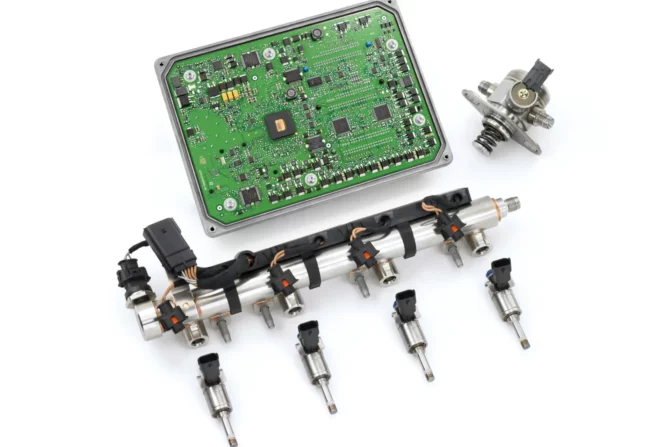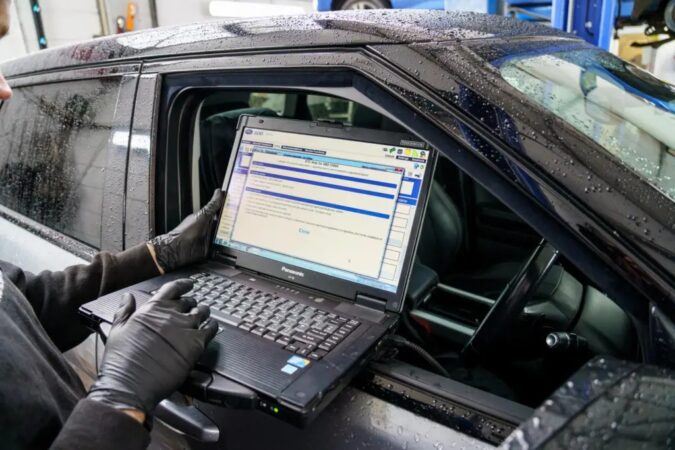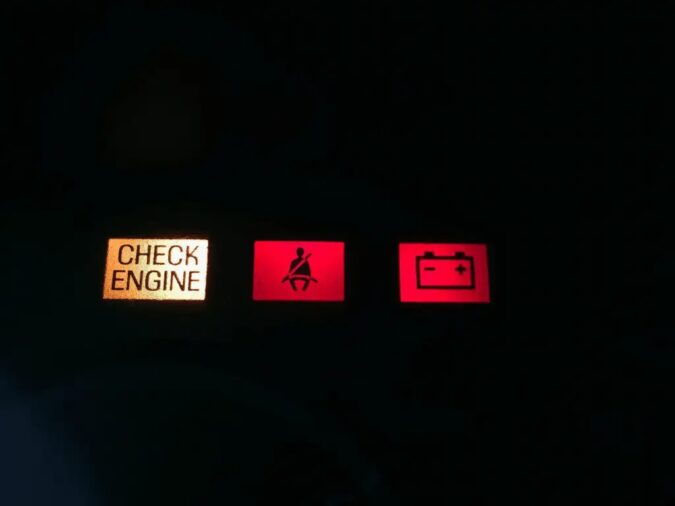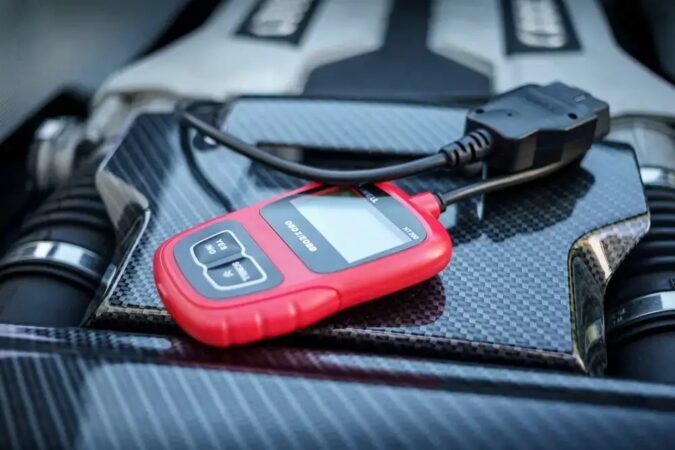If you own a car, you probably know about the different error codes and warning codes that your car may show from time to time. These codes are designed to alert you to potential issues with your car. Also, they help you diagnose and fix problems before they become more serious. One such code that you may encounter is the U0100 code.
This code means that there are problems with how your car’s different control modules talk to each other. This article will delve into the causes of the U0100 error code as well as how to diagnose and fix it.
- What Is U0100 Code?
- Causes Of U0100 Code
- Symptoms Of U0100
- How To Diagnose U0100?
- PCM vs ECM
- Last Words
- FAQs
U0100
The U0100 code is a diagnostic trouble code (DTC) that indicates a communication error between the engine control module (ECM) and the powertrain control module (PCM). The ECM and PCM are two of the main computerized control systems in a vehicle. They work together to manage the engine and transmission.
When the ECM and PCM are not able to communicate with each other, it can cause problems with the engine and transmission. That will also affect other systems that rely on their communication, such as the vehicle’s fuel system and emission control system. The latter is what results in emissions system problems, among others.
What Causes The U0100 Code
There can be numerous causes for this code. A mechanic will usually use a diagnostic tool to read the DTCs and run different tests to narrow down the cause of the communication error.
This could mean checking for damage in the wiring and control modules, running a data bus diagnostic test, or looking for problems with the software.
Here are some of the most common causes of a u0100 code:
1. Faulty Wiring
The wiring in a vehicle is responsible for transmitting power and information between different systems and components. If the wiring is damaged or corroded, it can cause communication issues between the ECM and PCM.
This could be because of physical damage to the wiring. That may result from a crash or a piece of debris, or because of corrosion resulting from exposure to the elements.
2. Damaged Control Modules
The ECM and PCM are two of the main control modules in a vehicle. They are in charge of the engine, transmission, and other systems like the fuel system and the system that controls emissions. If either of these modules is damaged, it can cause communication issues with the other control modules.
Damage to the control modules may be caused by factors such as water damage, electrical surges, or physical impact.
3. Problems With The Vehicle’s Data Bus
The data bus is a network of wires that allows different control modules to communicate with each other. If there is a problem with the data bus, it can disrupt communication between the ECM and PCM, as well as other control modules.
This may be due to issues with the data bus wiring or problems with the data bus connector. If the data bus network is faulty, you might also notice other OBD codes such as U1000, among others.
4. Other Control Module Issues
In some cases, issues with other control modules in the vehicle can cause communication problems between the ECM and PCM. For example, the ABS (anti-lock brake system) control module can develop a fault.
This control module is responsible for managing the ABS system, which helps the wheels on a vehicle maintain traction when braking.
When the ABS control module is not functioning properly, it can cause communication issues between the ECM and PCM. This is because the ECM and PCM are connected to the same data bus as the ABS control module.
Hence, a problem with the ABS control module can disrupt communication between the ECM and PCM, triggering the U0100 code.
Symptoms Of A Bad ECM
Some common symptoms of a U0100 code include:
U0100 Code, Symptoms #1: Check Engine Light Turning On
One of the main symptoms of a U0100 code is a malfunction indicator lamp (MIL) or “check engine” light. The engine light, also known as the check engine light, is a warning indicator that is designed to alert you to problems with your vehicle. If the engine light comes on, it could be a sign of a U0100 code or other issue.
For more insight into the check engine light, do check out our detailed explainers on:
- What to do when the check engine light comes on
- How to reset a check engine light
- What happens when the check engine light comes on and off
- Why is the check engine light flashing
- How to turn off the check engine light
- What is a gas cap check engine light
- Why is the check engine light blinking as your car is shaking
U0100 Code, Symptoms #2: Lack Of Communication Among The Modules
If the communication network is experiencing problems, it may be difficult or impossible for different systems and modules in your vehicle to communicate with each other. This can cause issues with your vehicle’s performance and functionality.
U0100 Code, Symptoms #3: Poor Performance And Decreased Fuel Efficiency
A malfunctioning communication network can lead to poor performance and decreased fuel efficiency.
U0100 Code, Symptoms #4: Difficulty Starting The Vehicle
Difficulties with the vehicle’s communication network might impede a vehicle’s ability to start. This is because the communication network is part of the starting process and is in charge of sending the signals needed to get the engine going.
If there is a problem with the communication network, the car may be unable to start or may start but then stall.
It’s important to note that a U0100 code can be caused by a variety of issues. The specific symptoms you experience may vary depending on the root cause of the problem. To make sure your car is safe and reliable, it’s best to have a mechanic figure out what’s wrong and fix it.
How To Diagnose The U0100 Code
Diagnosing and fixing the U0100 code can be a complex task. Moreover, we recommend that you have a qualified mechanic handle the repair if you are not comfortable doing it yourself. However, here are some DIY steps for diagnosing the U0100 code.
Diagnosing U0100 Code #1 – Connect A Diagnostic Tool
You will need a diagnostic tool that is compatible with your vehicle’s OBD-II system. Many auto parts stores and mechanics offer this service for a fee. However, you can purchase your own diagnostic tool and connect it to your vehicle’s OBD-II port, which is usually located under the dashboard on the driver’s side.
Diagnosing U0100 Code #2 – Check For Related Codes
These codes may be stored in the ECM or TCM, and they can provide clues as to the root cause of the U0100 code. For example, if you retrieve a code for a faulty sensor or actuator, it may be contributing to the communication issue between the ECM and TCM.
Diagnosing U0100 Code #3 – Retrieve Freeze Frame Data
Freeze frame data is a snapshot of the vehicle’s operating conditions at the moment the U0100 code was triggered. This data can help you understand the circumstances that triggered the code. That may help you discover the causes and fix them.
Diagnosing U0100 Code #4 – Check Wiring And Connections
Visually inspect the wiring and connections in the ECM and TCM circuits for any visible damage. This may include frayed wires, loose connections, or corrosion. If you find any damage, it will need to be repaired or replaced as necessary.
Diagnosing U0100 Code #5 – Test The Control Modules
Using a car diagnostic tool, you can put the ECM and TCM through a series of tests to see if either of them is broken. These tests may include checking input and output signals, as well as performing self-diagnostic checks.
Diagnosing U0100 Code #6 – Replace Or Repair Components
If the diagnostic tests show that either the ECM or the TCM is broken, they will need to be replaced. If the wiring or connections are broken, they will need to be fixed or replaced, depending on what is best.
Diagnosing U0100 Code #7 – Clear The DTC And Test The Vehicle
Once the issue has been resolved, use the diagnostic tool to clear the U0100 code and any other stored codes. Then, test the vehicle to ensure that the code does not reappear. If the code does reappear, it may be necessary to perform additional diagnosis and repairs.
Remember, diagnosing and fixing the U0100 code can be a complex task. We recommend you have a qualified mechanic handle the repair if you are not comfortable doing it yourself. Just make sure you’re aware of how much is for a car diagnosis.
Tips For Dealing With The U0100 Code
Fixing a U0100 code requires extreme professionalism and skill. It is recommended that you seek the services of a professional to avoid making costly mistakes. Here are some expert tips that can help you fix the U0100 code.
1. Replace Fuses And Relays
The engine control system relies on a number of fuses and relays to function properly. These fuses and relays can sometimes blow or fail, causing problems with the system. It is important to check all the relevant fuses and relays to ensure they are functioning properly.
If a damaged fuse or relay is found, replacing it might fix the U0100 code.
2. Wiring Harnesses And Connectors
A number of wire harnesses and connectors are used to transmit electrical signals and power throughout the engine control system. Wire harnesses and connections that are damaged, corroded, or loose might cause issues with the system.
All suitable connections and wire harnesses must be inspected for damage and repaired or replaced if any are found.
3. Replace Faulty Sensors
The engine control module relies on a number of sensors to find out how the engine and its different parts are doing. Some of these sensors are the mass air flow sensor, the throttle position sensor, and the crankshaft position sensor.
If any of these sensors are faulty or malfunctioning, it can cause problems with the engine control system. It is important to check all the relevant sensors and replace any that are faulty.
4. Replace Faulty Components Of The Fuel System
Replacing faulty fuel system components can be a complex task. Because it involves working with fuel lines and other components that work under pressure. It is important to use caution and follow proper safety procedures when working on the fuel system.
Here are some general steps to follow when replacing faulty fuel system components:
- Relieve fuel system pressure: Before you start working on the fuel system, you will need to relieve the fuel system pressure. This can usually be done by disconnecting the fuel pump fuse or relay and starting the engine until it stalls.
- Disconnect the battery: It is important to disconnect the battery before working on the fuel system to prevent the risk of fire or explosion.
- Drain the fuel tank: Depending on the location of the faulty component, you may need to drain the fuel tank.
- Disconnect the fuel lines: Before you can remove the faulty component, you will need to disconnect the fuel lines that are connected to it.
- Remove the faulty component: Once the fuel lines are disconnected, you can remove the faulty component.
- Install the new component: Follow the manufacturer’s instructions to install the new fuel system component.
- Reconnect the fuel lines: Reconnect the fuel lines to the new component.
- Refill the fuel tank: If you drained the fuel tank, refill it with the appropriate type of fuel.
- Reconnect the battery: Reconnect the battery and start the engine to test the new component.
Note that this is just a general outline for replacing faulty fuel system components. The exact steps will depend on the make and model of your car, as well as where the broken part is located.
PCM vs ECM
Again, these are just some potential fixes for a U0100 code, and the actual repair may vary depending on the specific vehicle and its symptoms. For a proper diagnosis and repair, you should always talk to a professional mechanic.
PCM stands for “Powertrain Control Module” and is a computer that controls the fuel and ignition systems in a vehicle. It is responsible for managing the engine and transmission to ensure that the vehicle operates efficiently.
ECM stands for “Engine Control Module.” It’s responsible for managing the fuel and ignition systems to ensure that the engine operates efficiently and meets emissions standards.
Both the PCM and ECM are important components of a vehicle’s electronic control system, and they work together to ensure that the vehicle runs smoothly and efficiently.
Symptoms Of A Bad PCM And ECM
The powertrain control module (PCM) and the engine control module (ECM) are both important components in a vehicle’s engine management system. They work together to control the different systems and functions of the engine and drivetrain.
If either the PCM or ECM is not functioning properly, it can cause a variety of problems with the vehicle.
Some common symptoms of a bad PCM or ECM include:
- Check Engine Light: If the PCM or ECM detects a problem, it will often trigger the “Check Engine” light on the dashboard.
- Engine performance issues: A malfunctioning PCM or ECM can cause problems with engine performance, such as a rough idle, a lack of power, or stalling.
- Transmission shifting problems: The PCM or ECM also controls the transmission, so if either of these modules is not working properly, it can cause shifting problems or even prevent the vehicle from moving.
- Fuel efficiency issues: If the PCM or ECM is not accurately controlling fuel delivery, it can lead to poor fuel efficiency or decreased gas mileage (which you can verify by learning how to calculate the gas mileage).
If you are experiencing any of these problems, it is possible that the PCM or ECM may be at fault. It’s important to have a mechanic check out the car to figure out what’s wrong and how to fix it.
How To Reprogram The PCM
Reprogramming the PCM (powertrain control module) is a process that involves updating the software that runs on the module. This is typically done to improve the performance or fix the U0100 code on a vehicle.
Here are the general steps for reprogramming a PCM:
- Determine if the PCM can be reprogrammed: Some PCMs are not able to be reprogrammed and must be replaced instead.
- Obtain the proper reprogramming equipment and software: This may include a laptop computer and a PCM programming tool.
- Connect the programming tool to the vehicle’s diagnostic port and to the computer.
- Follow the prompts on the programming software to select the correct software update for the vehicle.
- Download the update to the programming tool.
- Follow the prompts on the programming software to install the update on the PCM.
- Disconnect the programming tool and close the hood.
In summary, programming or reprogramming a PCM (powertrain control module) is typically done by connecting a diagnostic tool, such as a scan tool, to the vehicle’s OBD-II port and uploading the new software to the vehicle. This process is often performed by a dealer or an automotive repair shop.
However, do bear in mind that in many cases, a professional solution will incur a cost for reprogramming the PCM.
In some cases, you may be able to buy a replacement PCM that has already been programmed with the right software. However, you shouldn’t try to reprogram a PCM yourself unless you have the training and tools to do so.
ECM Repair Cost
How much it costs to fix a powertrain control module (PCM) depends on the make and model of your car, and how bad the repair is. In general, you can expect to pay between $100 and $1,000 for a PCM or ECM repair. However, some high-end vehicles can cost significantly more to repair.
It is always a good idea to get a few quotes from different repair shops or dealerships. That will help you compare prices and make sure you are getting a fair price for the repair. It is also a good idea to check with your auto insurance policy to see if it covers PCM or ECM repairs, as some policies may include this type of coverage.
Last Words On The U0100 Code
In conclusion, the U0100 code is an important diagnostic code you need to understand and fix in your vehicle when detected. It indicates a problem with the way the systems talk to each other.
That can cause the engine to run poorly, stall, misfire, or do other strange things. The communication system is responsible for transferring data between various modules and systems of the vehicle. Hence, if this system is not functioning correctly, it can cause serious problems and lead to costly repairs.
It is important to be aware of the symptoms of the U0100 code. That includes the check engine light coming on, poor engine performance, and stalling or misfiring. If you notice any of these signs, you should take care of the problem right away to keep your car from getting worse.
By being proactive and addressing the issue as soon as possible, you can save yourself time and money in the long run. To diagnose the U0100 code, use a diagnostic tool (OBDII scanner) to retrieve stored DTC codes from the PCM. There are several possible fixes for the U0100 code.
That includes repairing or replacing faulty wiring or connectors, replacing a faulty communication module, and updating software or firmware. We recommend that you address the U0100 code as soon as possible to avoid further damage, and to keep your car running smoothly.
FAQs About U0100 Code
If you’re curious to learn more about the U0100 code, our FAQs here might help…
What Does The Powertrain Control Module Do
The powertrain control module is a computer that controls the engine, transmission, and other related parts of a vehicle’s powertrain system. It gets information from sensors all over the car and uses this data to make real-time changes to the powertrain system to make sure the car runs at its best. The powertrain control module also checks and controls the vehicle’s emission system to make sure it meets federal standards for emissions.
How Often Does A PCM Go Bad
The powertrain control module is designed to last throughout the life of the vehicle. However, like any other component, it is subject to wear and tear and can go bad over time. The frequency at which a PCM goes bad can vary depending on a number of factors, including the quality of the component, the age of the vehicle, and the driving conditions. In general, it is rare for a PCM to go bad, but it is not uncommon for it to happen after several years of use.
Do You Have To Clear Code After Repair
It is usually necessary to clear codes after repairs have been made to a vehicle. To clear the codes, you will need to use a diagnostic tool and follow the manufacturer’s instructions carefully. By clearing the codes after repairs, you can make sure that the diagnostic system is accurately tracking the vehicle’s performance and can spot any new problems that may arise.
What Are The Symptoms Of A Bad Engine Control Module
Some of the symptoms of a bad engine control module include the check engine light coming on, the engine stalling or misfiring, poor fuel economy, decreased engine power, and difficulty starting the engine.




